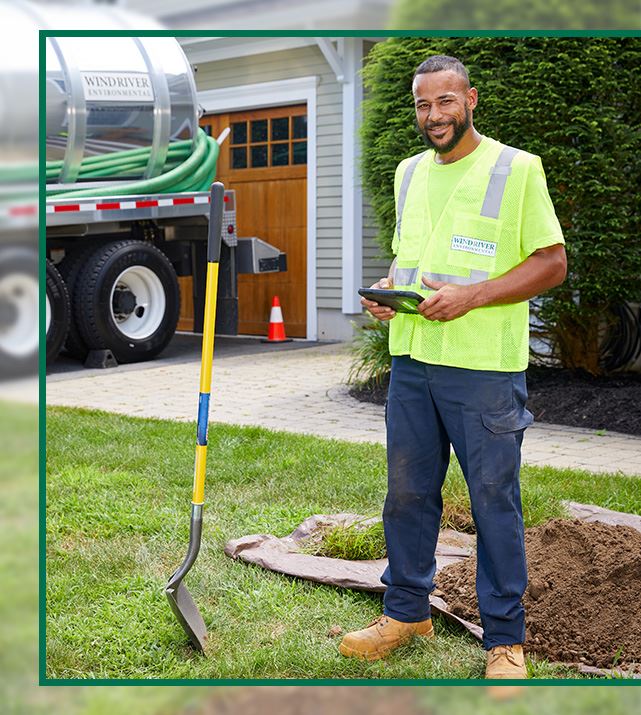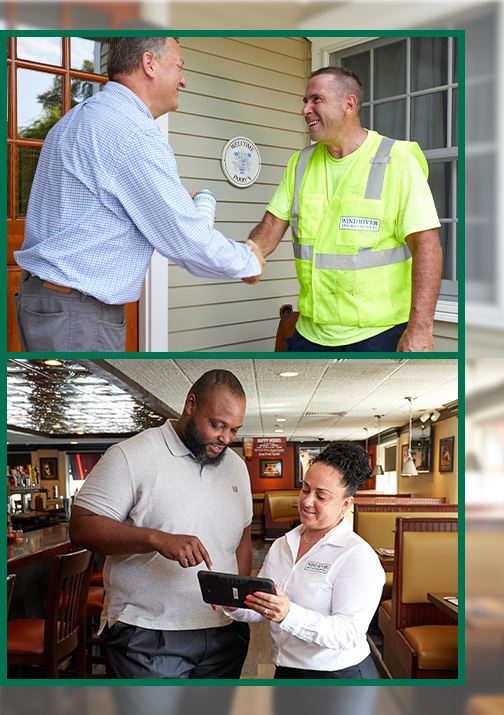
DMV Area Grease Trap Cleaning & Maintenance Services
B&P Environmental services interior and exterior grease traps of all sizes, from 5 gallons to 20,000 gallons or more. With multiple disposal locations and a fleet capacity in excess of 30,000 gallons, we do not turn down any job for being too small or too large. Any size, location, and level of difficulty can be handled by B&P Environmental. We offer 24/7 emergency services, so any grease trap can be serviced at any hour to suit our customer needs and schedules. B&P Environmental offers grease trap pumping services for restaurant chains, malls, plazas, and more across the Maryland, DC, Virginia, Delaware, and Pennsylvania area.
One call does it all, so dial (443) 292-9259 or contact us online to request a free site visit and estimate for grease trap services!
Understanding Grease Traps: Protecting Your Plumbing
Fats, Oils, and Greases (FOGs) are a major problem for municipalities, property owners, and restaurants alike. FOGs are washed down the drain and then congeal and collect on the inside of the pipes. Over time, this will lead to flow restrictions and eventually result in major backups. A grease trap, or a grease interceptor, is a plumbing device that intercepts and capture FOGs and food sludge from wastewater before it gets into the sewer system. This collected grease is now no longer going to back up sewer systems – but now it is your responsibility to remove the accumulated FOGs and food sludge.
Benefits of Regular Grease Trap Maintenance
Regular grease trap cleaning and maintenance is essential for the proper functioning of your plumbing system and to comply with local regulations. Neglecting your grease trap can lead to clogs, foul odors, and even sewage backups. By scheduling routine maintenance with B&P Environmental, you can avoid costly repairs and ensure the smooth operation of your commercial kitchen.
Some benefits of regular grease trap maintenance include:
- Preventing clogs and backups
- Extending the lifespan of your plumbing system
- Reducing the risk of foul odors
- Compliance with local health regulations
- Cost savings in the long run
Our DMV Grease Trap Pumping Services
Routine Grease Trap Pumping
Regular pumping to keep your grease traps functioning efficiently:
- Scheduled Pumping: Customized maintenance schedules to ensure your grease traps are pumped regularly, preventing clogs and backups.
- Efficient Removal: Thorough removal of accumulated grease, fats, oils, and food particles to maintain optimal flow.
- Waste Disposal: Safe and environmentally-friendly disposal of grease trap waste in accordance with local regulations.
Emergency Grease Trap Pumping
Rapid response services to address urgent grease trap issues:
- 24/7 Availability: Immediate assistance for emergency grease trap pumping to prevent downtime and health hazards.
- Quick Response: Fast and efficient service to resolve urgent blockages and overflows, minimizing disruption to your business.
- Preventive Measures: Recommendations and services to prevent future emergencies and maintain a healthy plumbing system.
Comprehensive Grease Trap Maintenance
Ongoing maintenance services to ensure your grease traps operate efficiently:
- Regular Inspections: Scheduled inspections to identify potential issues and address them before they become major problems.
- Component Checks: Examination and maintenance of all grease trap components to ensure they are functioning correctly.
- Performance Optimization: Adjustments and recommendations to enhance the performance and longevity of your grease trap system.
Compliance Assistance
Helping you stay compliant with local health and safety regulations:
- Documentation: Providing necessary documentation and reports for health inspections and regulatory compliance.
- Consultation: Expert advice and consultation on best practices and compliance requirements for grease trap management.
- Training: Training your staff on proper grease trap maintenance and usage to ensure ongoing compliance.
Proactive Grease Trap Management: Tips & Best Practices
It all starts with good kitchen management and practices. Common steps to take to avoid problems include:
- Minimizing food waste going into the drains. Food waste should go into the trash can, not into the sink.
- Wipe down greasy pots and pans with a paper towel before washing them.
- Install strainers in sinks to capture any remaining food waste. Properly dispose of any food waste captured by the strainers into a trash can.
- Never pour used fryer oil or place cooking griddle waste into the sink.
- Dispose of used fryer oil into a grease container provided by B&P Environmental for recycling.
Contact Us
For reliable and professional grease trap pumping services in the DMV and Maryland, trust the experts at B&P Environmental. Contact us today to schedule an appointment or request a free estimate.
Grease Trap FAQ
Q: How often should my grease trap be pumped?
A: The frequency of pumping depends on the volume of grease your kitchen produces. Most commercial kitchens benefit from monthly pumping, but high-volume establishments may require more frequent service.
Q: What are the signs that my grease trap needs pumping?
A: Slow drainage, foul odors, and frequent backups are common signs that your grease trap needs pumping.
Q: Can I pump my grease trap myself?
A: While minor maintenance can be done by staff, professional pumping is recommended to ensure thorough removal of grease and compliance with regulations.
Q: What happens if my grease trap overflows?
A: An overflowing grease trap can cause severe plumbing issues, foul odors, and health hazards. Contact us immediately for emergency pumping and repair services.
Q: How can I prevent grease buildup in my trap?
A: Regular pumping, proper disposal of fats and oils, and staff training on best practices can help prevent excessive grease buildup.
Q: Are there regulations for grease trap maintenance?
A: Yes, local health and environmental regulations often require regular maintenance and documentation. We can help ensure your business remains compliant.
Q: What size grease trap do I need?
A: The size of your grease trap depends on your kitchen’s output and the volume of grease produced. We can assess your needs and recommend the appropriate size.
Q: Do you offer maintenance contracts for grease trap pumping?
A: Yes, we offer flexible maintenance contracts tailored to your business needs, ensuring regular pumping services and optimal plumbing performance.



Why Choose B & P Environmental?
-
Experienced Service ProviderWe have over 400 years of experience combined with all of our employees. There's nothing we haven’t seen in this industry.
-
24/7 Scheduling AvailabilityDays, nights, weekends, national holidays—we’re always available online to book your service.
-
Self-Service Online SchedulingOur technicians can enhance service with all of the capabilities of our online portal.
-
Multiple Service OfferingsOur services range from liquid waste management to drain services and beyond.
-
Trusted by The U.S. GovernmentAuthorized to work on government, military and all other federal installations.
How Often Should A Grease Trap Be Cleaned?
Grease traps can vary wildly in usage, size, design, and location. All these factors will determine how often a grease trap should be cleaned. To make it simple, you want to clean a grease trap when it is one quarter ‘full’ at a minimum – that means the food sludge on the bottom and the FOGs on the top do not exceed one-quarter of the volume of the grease trap. However, many grease traps should be cleaned much more often than the simple one-quarter rule would dictate. For example, if you look at a grease trap that is 1,500 gallons, one quarter would be 375 gallons of FOGs, which is way too much! Oftentimes, the grease will be so hard by this time that you can stack bricks on top of it!
We recommend our customers have their grease trap pumping services happen every one to three months. The local regulatory authorities will often dictate the cleaning frequency of your grease trap.
One call does it all, so dial (443) 292-9259 or contact us online to request a free site visit and estimate!


"Give the team at B&P Environmental a call!"They have earned our respect and our business! Your search for a septic service company is over!
- Joshua T.


What Happens If I Do Not Clean My Grease Trap?
Failure to maintain your grease trap will eventually lead to a number of issues that can be costly to rectify. The trap will become less effective, allowing the FOGs to pass through the system and accumulate in the pipes. In such situations, B&P Environmental can be contracted to hydro jet the pipes, leaving the lines as clean as new.
The corrosive nature of the grease trap contents can also degrade the trap. Steel traps will corrode from the inside, and the corrosive liquid contents can degrade the crystalline structure of concrete, breaking concrete baffles, or seriously damaging the load-bearing structure of the trap, leading to serious safety concerns and potentially a total collapse of the grease trap. A large accumulation of grease trap FOGs can also cause a massive blockage. A sink may not drain, or the contents of the trap may overflow inside or outside of the building, causing an extensive mess that requires a specialized, costly emergency cleanup.
In many cases, the backup manifests itself as a total blockage of the sanitary plumbing system, causing all restrooms, sinks, and floor drains to back up. This results in potentially costly property damage, as well as regulatory fines from governmental environmental and regulatory institutions.